

AWS Config is a service that enables you to assess, audit, and evaluate the configurations of your AWS resources. This can be used for:
- security: validate security best practices on your AWS Account
- compliance: report on deviations on configuration for AWS resources based upon best practices or architectural principles and guidelines
- efficiency: report on lost or unused resources in your AWS Account
In this blog post, I’d like to detail how to monitor your cloud resources with this tool. This first part discusses AWS Config account setup, enabling notifications when resources are not compliant, and deployment.
Why use AWS Config?
AWS is the main cloud platform we use at ACA. We manage multiple accounts in AWS to host all sorts of applications for ourselves and for our customers. Over the years, we set up more and more projects in AWS. This led to a lot of accounts being created, which in turn use a lot of cloud resources. Naturally, this means that keeping track of all these resources becomes increasingly challenging as well.
AWS Config helped us deal with this challenge. We use it to inventorize and monitor all the resources in our entire AWS organization. It also allows us to set compliance rules for our resources that need to be conform in every account. For example: an Elastic IP should not be left unused or an EC2 security group should not allow all incoming traffic without restrictions. This way, we’re able to create a standard for all our AWS accounts.
Having AWS Config enabled in your organization gives us a couple of advantages.
- We always have an up-to-date inventory of all the resources in our accounts.
- It allows to inspect the change history of all our resources 24/7.
- It gives us the possibility to create organization rules and continuously check if our resources are compliant. If that’s not the case, we instantly get a notification.
Setting up AWS Config for a single account
In this first part of my AWS Config blog, I want to show how to set up AWS Config in a single account. In a future blog post, I’ll explain more about you can do this for an entire AWS organization. The image below shows an overview of the setup in a single account, containing
- the AWS Config recorder,
- the AWS Config rules,
- and the S3 bucket.
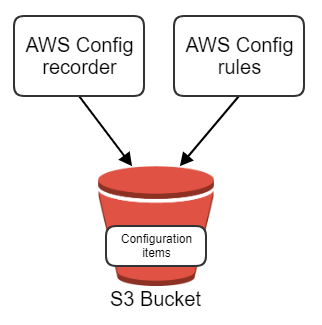
The AWS Config recorder is the main component of the set-up. You can turn on the default recorder in the AWS console. By default, it will record all resource types. You can find more information about all the available resource types on this page.
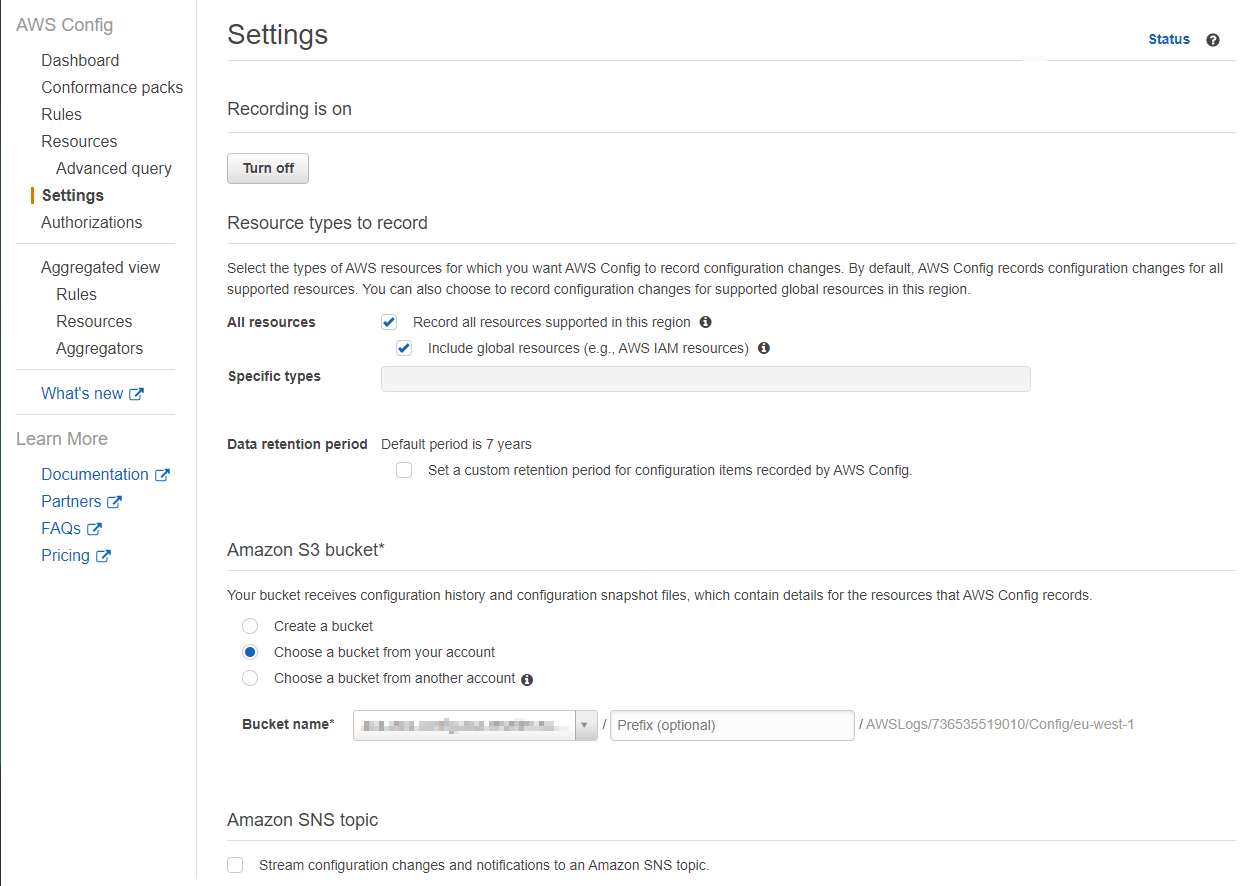
When you start recording, all the the AWS resources are stored in the S3 bucket as configuration items. Recording these configuration items is not free. At the point of writing it costs $0.003 per recorded configuration item. This cost is generated when the configuration item is first recorded or when something changes to it or one of its relationships. In the settings of the AWS Config recorder, you can also specify how long these configuration items should be stored in the S3 bucket.
The AWS Config rules are the most important part of your setup. These rules can be used as compliancy checks to make sure the resources in your account are configured as intended. It’s possible to create custom rules or choose from a large set of AWS managed rules. In our setup at ACA, we chose to only use AWS managed rules since they fitted all our needs. In the image below, you can see one of the rules we deployed.
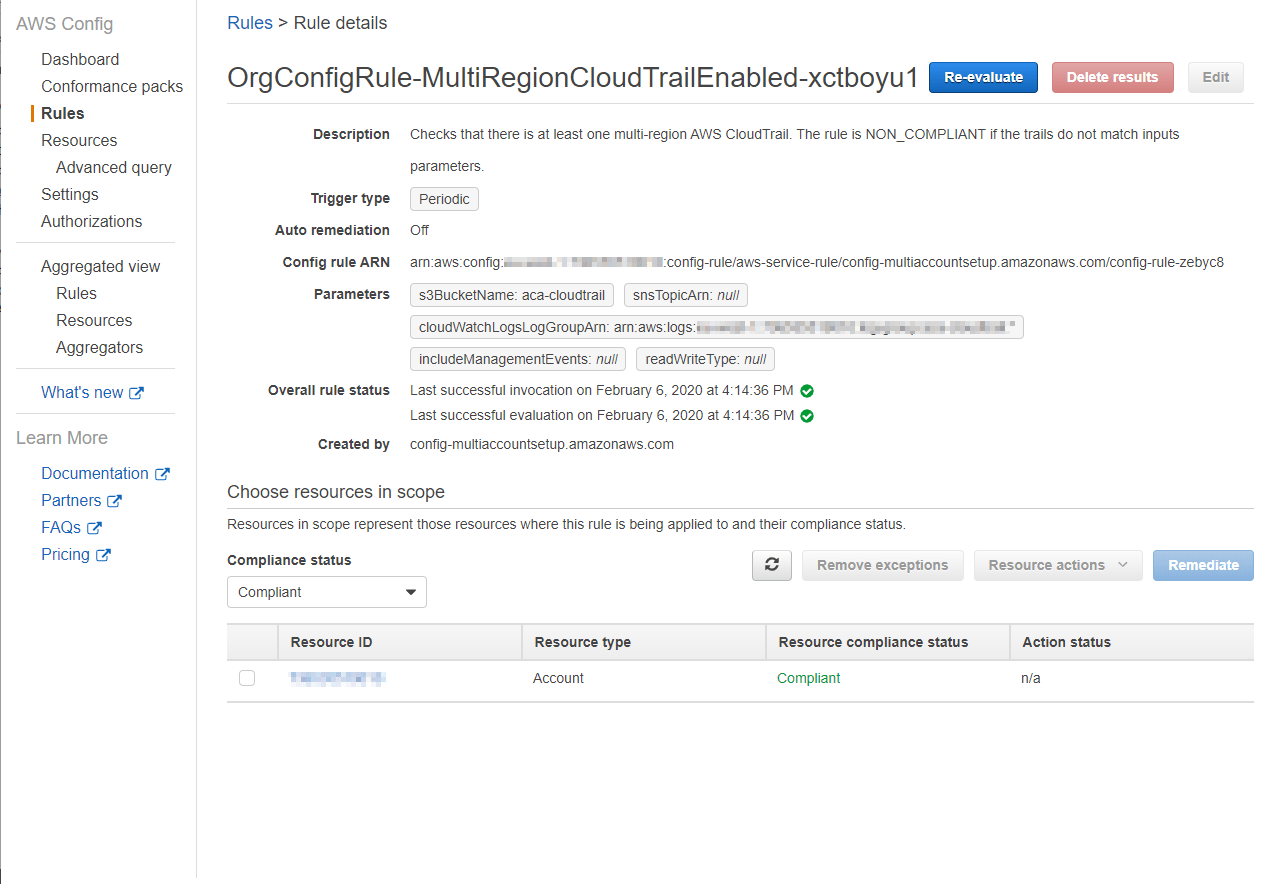
Just like recording configuration items, running rule evaluations costs money. At the moment of writing this is $0.001 for the first 100.000 rule evaluations per region, $.0008 from 100.000 – 500.000 and after that $.0005.
There are a lot of rules available with different benefits to your AWS account. These are some of the AWS managed rules we configured:
- Rules that improve security
- AccessKeysRotated: checks if the Access keys of an IAM user are rotated within a specified amount of days
- IamRootAccessKeyCheck: checks if a root account has access keys assigned to it, which isn’t recommended
- S3BucketServerSideEncryptionEnabled: checks if default encryption for a S3 bucket is enabled
- Rules that detect unused resources (cost reduction)
- Ec2VolumeInuseCheck: checks if an EBS volume is being used
- EipAttached: checks if an Elastic IP is being used
- Rules that detect resource optimizations
- VpcVpn2TunnelsUp: checks if a VPN connection has two tunnels available
Setting up notifications when resources are not compliant
AWS Config rules check configuration items. If a configuration item doesn’t pass the rule requirements, it is marked as ‘non compliant’. Whenever this happens, you want to be notified so you can take the appropriate actions to fix it. In the image below, you can see the way we implemented the notifications for our AWS Config rules.

To start with notifications, CloudTrail should be enabled and there should be a trail that logs all activity in the account. Now CloudWatch is able to pick up the CloudTrail events. In our setup, we created 5 CloudWatch event rules that send notifications according to priority. This makes it possible for us to decide what the priority level of the alert for each AWS Config rule should be. The image below shows an example of this.
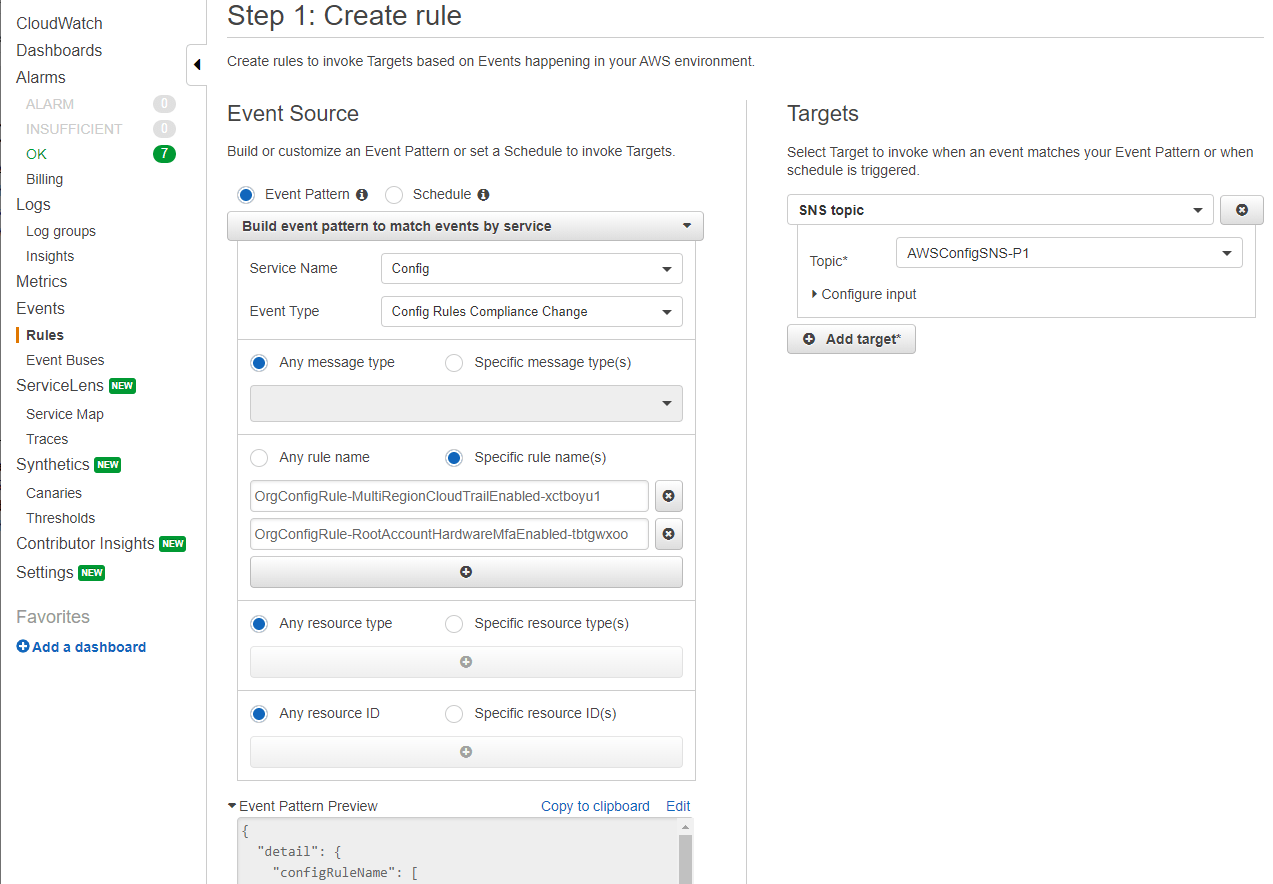
In the ‘Targets’ section, you can see the SNS topic which receives the messages of the CloudWatch event rule. Opsgenie has a separate subscription for each of the SNS topics (P1, P2, P3, P4 & P5). This way, we receive notifications when compliance changes happen and also see the severity by looking at the priority level from our Opsgenie alert.
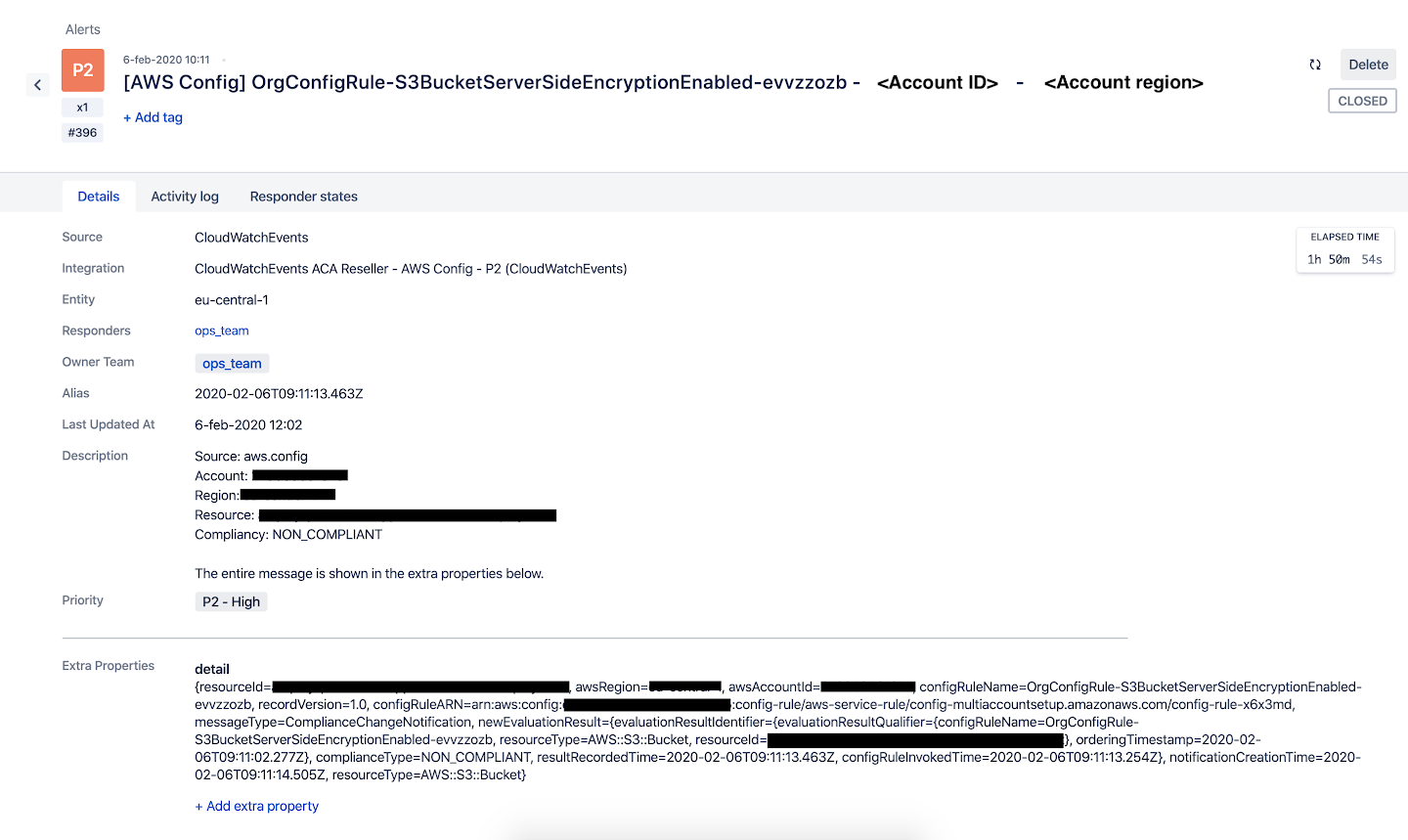
Deploying your AWS Config
At ACA, we try to always manage our AWS infrastructure with Terraform. This is no different for AWS Config. This is our deployment workflow:

We manage everything AWS Config related in Terraform. Here’s an example of one of the AWS Config rules in Terraform, in which the rule_identifier attribute value can be found in the documentation of the AWS Config managed rules:
resource "aws_config_config_rule" "mfa_enabled_for_iam_console_access" {
name = "MfaEnabledForIamConsoleAccess"
description = "Checks whether AWS Multi-Factor Authentication (MFA) is enabled for all AWS Identity and Access Management (IAM) users that use a console password. The rule is compliant if MFA is enabled."
rule_identifier = "MFA_ENABLED_FOR_IAM_CONSOLE_ACCESS"
maximum_execution_frequency = "One_Hour"
excluded_accounts = "${var.aws_config_organization_rules_excluded_accounts}"
}The Terraform code is version controlled with Git. When the code needs to be deployed, Jenkins does a checkout of the Git repository and deploys it to AWS with Terraform.
Takeaway
With AWS Config we’re able to get more insights in our AWS cloud resources. AWS Config improves our security, avoids keeping resources around that are not being used and makes sure our resources are being configured in an optimal way. Besides these advantages, it also provides us with an inventory of all our resources and their configuration history, which we can inspect at any time.
This concludes this blog post on the AWS Config topic. In a future part I want to explain how to set it up for an AWS organization. If you found this topic interesting and you got a question or if you would like to know more about our AWS Config setup, then please reach out to us at cloud@aca-it.be
What others have also read


In the complex world of modern software development, companies are faced with the challenge of seamlessly integrating diverse applications developed and managed by different teams. An invaluable asset in overcoming this challenge is the Service Mesh. In this blog article, we delve into Istio Service Mesh and explore why investing in a Service Mesh like Istio is a smart move." What is Service Mesh? A service mesh is a software layer responsible for all communication between applications, referred to as services in this context. It introduces new functionalities to manage the interaction between services, such as monitoring, logging, tracing, and traffic control. A service mesh operates independently of the code of each individual service, enabling it to operate across network boundaries and collaborate with various management systems. Thanks to a service mesh, developers can focus on building application features without worrying about the complexity of the underlying communication infrastructure. Istio Service Mesh in Practice Consider managing a large cluster that runs multiple applications developed and maintained by different teams, each with diverse dependencies like ElasticSearch or Kafka. Over time, this results in a complex ecosystem of applications and containers, overseen by various teams. The environment becomes so intricate that administrators find it increasingly difficult to maintain a clear overview. This leads to a series of pertinent questions: What is the architecture like? Which applications interact with each other? How is the traffic managed? Moreover, there are specific challenges that must be addressed for each individual application: Handling login processes Implementing robust security measures Managing network traffic directed towards the application ... A Service Mesh, such as Istio, offers a solution to these challenges. Istio acts as a proxy between the various applications (services) in the cluster, with each request passing through a component of Istio. How Does Istio Service Mesh Work? Istio introduces a sidecar proxy for each service in the microservices ecosystem. This sidecar proxy manages all incoming and outgoing traffic for the service. Additionally, Istio adds components that handle the incoming and outgoing traffic of the cluster. Istio's control plane enables you to define policies for traffic management, security, and monitoring, which are then applied to the added components. For a deeper understanding of Istio Service Mesh functionality, our blog article, "Installing Istio Service Mesh: A Comprehensive Step-by-Step Guide" , provides a detailed, step-by-step explanation of the installation and utilization of Istio. Why Istio Service Mesh? Traffic Management: Istio enables detailed traffic management, allowing developers to easily route, distribute, and control traffic between different versions of their services. Security: Istio provides a robust security layer with features such as traffic encryption using its own certificates, Role-Based Access Control (RBAC), and capabilities for implementing authentication and authorization policies. Observability: Through built-in instrumentation, Istio offers deep observability with tools for monitoring, logging, and distributed tracing. This allows IT teams to analyze the performance of services and quickly detect issues. Simplified Communication: Istio removes the complexity of service communication from application developers, allowing them to focus on building application features. Is Istio Suitable for Your Setup? While the benefits are clear, it is essential to consider whether the additional complexity of Istio aligns with your specific setup. Firstly, a sidecar container is required for each deployed service, potentially leading to undesired memory and CPU overhead. Additionally, your team may lack the specialized knowledge required for Istio. If you are considering the adoption of Istio Service Mesh, seek guidance from specialists with expertise. Feel free to ask our experts for assistance. More Information about Istio Istio Service Mesh is a technological game-changer for IT professionals aiming for advanced control, security, and observability in their microservices architecture. Istio simplifies and secures communication between services, allowing IT teams to focus on building reliable and scalable applications. Need quick answers to all your questions about Istio Service Mesh? Contact our experts
Read more

On December 7 and 8, 2023, several ACA members participated in CloudBrew 2023 , an inspiring two-day conference about Microsoft Azure. In the scenery of the former Lamot brewery, visitors had the opportunity to delve into the latest cloud developments and expand their network. With various tracks and fascinating speakers, CloudBrew offered a wealth of information. The intimate setting allowed participants to make direct contact with both local and international experts. In this article we would like to highlight some of the most inspiring talks from this two-day cloud gathering: Azure Architecture: Choosing wisely Rik Hepworth , Chief Consulting Officer at Black Marble and Microsoft Azure MVP/RD, used a customer example in which .NET developers were responsible for managing the Azure infrastructure. He engaged the audience in an interactive discussion to choose the best technologies. He further emphasized the importance of a balanced approach, combining new knowledge with existing solutions for effective management and development of the architecture. From closed platform to Landing Zone with Azure Policy David de Hoop , Special Agent at Team Rockstars IT, talked about the Azure Enterprise Scale Architecture, a template provided by Microsoft that supports companies in setting up a scalable, secure and manageable cloud infrastructure. The template provides guidance for designing a cloud infrastructure that is customizable to a business's needs. A critical aspect of this architecture is the landing zone, an environment that adheres to design principles and supports all application portfolios. It uses subscriptions to isolate and scale application and platform resources. Azure Policy provides a set of guidelines to open up Azure infrastructure to an enterprise without sacrificing security or management. This gives engineers more freedom in their Azure environment, while security features are automatically enforced at the tenant level and even application-specific settings. This provides a balanced approach to ensure both flexibility and security, without the need for separate tools or technologies. Belgium's biggest Azure mistakes I want you to learn from! During this session, Toon Vanhoutte , Azure Solution Architect and Microsoft Azure MVP, presented the most common errors and human mistakes, based on the experiences of more than 100 Azure engineers. Using valuable practical examples, he not only illustrated the errors themselves, but also offered clear solutions and preventive measures to avoid similar incidents in the future. His valuable insights helped both novice and experienced Azure engineers sharpen their knowledge and optimize their implementations. Protecting critical ICS SCADA infrastructure with Microsoft Defender This presentation by Microsoft MVP/RD, Maarten Goet , focused on the use of Microsoft Defender for ICS SCADA infrastructure in the energy sector. The speaker shared insights on the importance of cybersecurity in this critical sector, and illustrated this with a demo demonstrating the vulnerabilities of such systems. He emphasized the need for proactive security measures and highlighted Microsoft Defender as a powerful tool for protecting ICS SCADA systems. Using Azure Digital Twin in Manufacturing Steven De Lausnay , Specialist Lead Data Architecture and IoT Architect, introduced Azure Digital Twin as an advanced technology to create digital replicas of physical environments. By providing insight into the process behind Azure Digital Twin, he showed how organizations in production environments can leverage this technology. He emphasized the value of Azure Digital Twin for modeling, monitoring and optimizing complex systems. This technology can play a crucial role in improving operational efficiency and making data-driven decisions in various industrial applications. Turning Azure Platform recommendations into gold Magnus Mårtensson , CEO of Loftysoft and Microsoft Azure MVP/RD, had the honor of closing CloudBrew 2023 with a compelling summary of the highlights. With his entertaining presentation he offered valuable reflection on the various themes discussed during the event. It was a perfect ending to an extremely successful conference and gave every participant the desire to immediately put the insights gained into practice. We are already looking forward to CloudBrew 2024! 🚀
Read more

In my previous blog post, I emphasized the importance of gathering data. However, in some cases you might not have any suitable data available. You might have raw data, but perhaps it’s unlabeled and unfit for machine learning. If you don’t have the financial resources to label this data, or you don’t have a product like reCAPTCHA to do it for free, there’s another option. Since Amazon launched its Amazon Web Services cloud platform as a side-business over a decade ago, it has grown at a tremendous pace. AWS offers now more than 165 services, giving anyone, from startups to multinational corporations, access to a dependable and scalable technical infrastructure. Some of these services offer what we call pre-trained machine learning models. Amazon’s pre-trained machine learning models can recognize images or objects, process text, give recommendations and more. The best part of it all is that you are able to use services based on Deep Learning without having to know anything about machine learning at all. These services are trained by Amazon, using data from its websites, its massive product catalog and its warehouses. The information on the AWS websites might be a bit overwhelming at first. That’s why in this blog post I would like to give an overview of a few services using Amazon’s machine learning models, which I think can easily be introduced into your applications. Computer vision with Rekognition Amazon Rekognition is a service that analyzes images and videos. You can use this service to identify people’s faces, everyday objects or even different celebrities. Practical uses are adding labels to videos, for instance following the ball during a football match, or picking out celebrities in an audience. Since Rekognition also has an API to compare similarities between persons in multiple images, you can use it to verify someone’s identity or automatically tag friends on social media. Speaking of social media: depending on the context of a platform, some user contributions might not be deemed acceptable. Through Rekognition, a social media platform can semi-automatically control suggestive or explicit content, giving the opportunity to blur or deny uploaded media when certain labels are associated with it. Digitalize archives with Textract Amazon Textract allows you to extract text from a scanned document. It uses Optical Character Recognition (OCR) and goes a step further by taking context into account. If your company receives a lot of printed forms instead of their digital counterpart, you might have a few thousand papers you need to digitalize manually. With regular OCR, it’s challenging to detect where a form label ends and a form field begins. Likewise it would be difficult for OCR to read newspapers, when text is placed in two or more columns. Textract is able to identify which group of words belong together, whether it’s a paragraph, a form field or a data table, helping you to reduce the time and effort you need to digitalize those archives. Analyze text with Comprehend Amazon Comprehend is a Natural Language Processing (NLP) service. It helps you discover the subject of a document, key phrases, important locations, people mentioned and more. One of its features is to analyze sentiment in a text. This can give you a quick insight in interactions with customers: are they happy, angry, satisfied? Amazon Comprehend can even highlight similar frustrations around a certain topic. If reviews around a certain product are automatically found to be mostly positive, you could easily incorporate this in a promotional campaign. Similarly if reviews are mostly negative, that might be something to forward to the manufacturer. A subservice of Comprehend called Comprehend Medical, is used to mine patient records and extract patient data and treatment information. Its goal is to help health care providers to quickly get an overview of previous interactions with a patient. By identifying key information from medical notes and adding some structure to it, Comprehend Medical assists medical customers to process a ton of documents in a short period of time. Take notes with Transcribe Amazon Transcribe is a general-purpose service to convert speech to text, with support for 14 languages. It automatically adds punctuation and formatting, making the text easier to read and search through. A great application for this is creating a transcript from an audio file and sending it to Comprehend for further analysis. A call center could use real-time streaming transcription to detect the name of a customer and present their information to the operator. Alternatively, the call center could label conversations with keywords to analyze which issues arise frequently. One of Transcribe’s features is to identify multiple speakers. This is useful for transcribing interviews or creating meeting minutes without having one of the meeting participants spend extra time jotting everything down. Multilingual with Translate When you’re getting reactions from customers on your products, you can translate them into your preferred language, so you can grasp subtle implications of certain words. Or you can extend your reach by translating your social media posts. You can even combine Transcribe and Translate to automatically generate subtitles for live events in multiple languages. Express yourself with Polly The Polly service can be considered the inverse of Transcribe. With Polly, you can convert text to speech, making the voice sound as close to natural speech as possible. With support for over 30 languages and many more lifelike voices, nothing is stopping you from making your applications talk back to you. Polly has some support for Speech Synthesis Markup Language (SSML), which gives you more control on how certain parts of the text are pronounced. Besides adding pauses, you can put emphasis on words, exchange acronyms with their unabbreviated form and even add breathing sounds. This amount of customization makes it possible to synthesize voice samples that sound very natural. Generating realistic speech has been a key factor to the success of apps like Duolingo , where pronunciation is of great significance. You can read about this particular use case in this blogpost . Bonus: if you don’t feel like reading, you can have it read to you by Polly! Make suggestions with Personalize When you look for any product on Amazon’s website , you immediately get suggestions for similar products or products that other customers have bought in combination. It’s mind blowing that out of the millions of items offered by Amazon, you get an accurate list of related products at the same moment the page loads. This powerful tool is available to you through Amazon Personalize . You need to provide an item inventory (products, documents, video’s, …), some demographic information about your users, and Personalize will combine this with an activity stream from your application to generate recommendations either in real-time or in bulk. This can easily be applied to a multitude of applications. You can present a list of similar items to customers of a webshop. A course provider would be able to suggest courses similar to a topic of interest. Found a restaurant you liked? Here’s a list of similar restaurants in your area. If you can provide the data, Personalize can provide the recommendations. Create conversations with Lex Amazon Lex is a service that provides conversational AI. It uses the same Natural Language Understanding technology as Amazon’s virtual assistant Alexa. Users can chat to your application instead of clicking through it. Everything starts with an intent . This defines the intention of the user, the goal we want to achieve for our user. It can be as simple as scheduling an appointment, providing directions to a location or getting a recipe that matches a list of ingredients. Intents are triggered by utterances . An utterance is something you say that has meaning. “I need an appointment with Dr. Smith”, “When can I see Dr Smith?”, “Is Dr. Smith available next week Wednesday?” are all utterances for the same intent: making an appointment. Lex is powerful enough to generalize these utterances so that slight variations can also trigger the correct intent. Finally, in the case of registering an appointment, you need to specify a few slots , pieces of data required for the user to provide in order to fulfill the intent. In the case of the example above, the name of the person you want to see, the time period and perhaps the reason of your visit. Even though the requirements are pretty simple, everything depends on the quality of the utterances and the chaining of intents. If you don’t have enough sample sentences or the conversation keeps asking information that the user already presented, your user will end up frustrated and overwhelmed. Predict demand with Forecast A fairly new service provided by AWS is called Forecast . This service also emerged from Amazon’s own necessity to estimate the demand for their immense product inventory. With Forecast, you can get insight in historical time series data. For instance, you could analyze the energy consumption of a region to project it to the near future. This gives you a probability of what the electricity demand tomorrow would be. Likewise, you might be able to predict that a component of your production facility needs maintenance before it wears out. Forecast can leverage Automated Machine Learning (AutoML) to find the optimal learning parameters to fit your use case. The quality of this services depends on the amount and quality of the data you can provide. This service used to be only available to a select group until very recently, but is now available to everyone. You can sign up for Forecast here . 🚀 Takeaway If you want to bring machine learning to your customers but are held back by a lack of understanding, Amazon offers out-of-the-box services to add intelligence to your applications. These services, trained and used by Amazon, can help your business grow and can give a personal experience to your customers, without any prior knowledge on machine learning.
Read moreWant to dive deeper into this topic?
Get in touch with our experts today. They are happy to help!

Want to dive deeper into this topic?
Get in touch with our experts today. They are happy to help!

Want to dive deeper into this topic?
Get in touch with our experts today. They are happy to help!

Want to dive deeper into this topic?
Get in touch with our experts today. They are happy to help!


